Summary of March itinerary in Japan (Hiroshima, Okayama)
I traveled to Hiroshima and Okayama prefectures from March 22nd (Tuesday) to March 25th (Friday). I was able to eat a lot of seasonal fish and shellfish and local dishes, and visited wonderful tourist destinations such as World Heritage Sites, National Treasures, National Important Cultural Properties, and National Preservation Districts for Groups of Traditional Buildings on this trip. It was the most visited tourist destination in the four-day domestic trip so far.
I was able to enjoy fresh seafood such as seasonal oysters and agricultural products unique to the production areas such as Kuwai (sagittaria rhizome, Fukuyama City) and Yellow Chinese chives (Kurashiki City), which are overwhelmingly produced in Japan on this trip. In addition, I was able to eat Hiroshima-style okonomiyaki and Onomichi ramen, which are typical local gourmet foods. This is the March Japan itinerary that I highly recommend to everyone. Here is a summary of this trip and some notes.
Table of contents
1.”100 best of local dishes” and “Local dishes loved by the nation” by this itinerary in Japan
2. Seasonal “PRIDE FISH” by this itinerary in Japan
3. Travel precautions for itinerary in Japan
As I repeat every time, this itinerary was created with the purpose of “eating out seasonal fish and shellfish and local dishes.” Food is the highest priority, and tourist destinations are the second priority. However, I aimed to visit as many tourist attractions as possible, such as World Heritage Sites, National Treasures, National Important Cultural Properties, and National Preservation Districts for Groups of Traditional Buildings.
1.”100 best of local dishes” and “Local dishes loved by the nation” by this itinerary in Japan
Hiroshima Prefecture: Anago meshi, (Kaki no dote nabe), Hiroshima-style okonomiyaki
In Hiroshima prefecture, I was able to eat “Anago meshi (Conger eel rice)” from the “100 best of local dishes” selected by the Ministry of Agriculture, Forestry and Fisheries. However, I only ate a mini size (tea bowl size) of Anago meshi at a soba restaurant. The next time I visit Hiroshima, I am determined to eat Anago meshi at a specialty store.
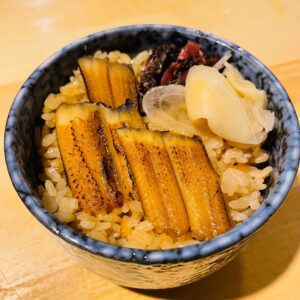
I could eat only a small amount of “Anago meshi”, but I was able to eat the sashimi of conger eel twice. In particular, I ate conger eel skin parboil for the first time and was impressed by its taste and texture.
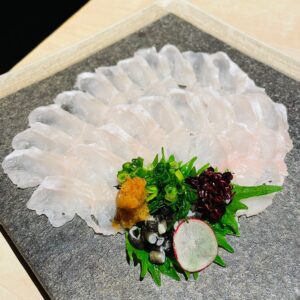
I couldn’t eat “Kaki no dote nabe (hot-pot meal featuring oysters and a miso broth, cooked at the table)”, but I could eat the lightly deep-fried oysters and steamed oysters. The oysters eaten in the plump and fat production center were the best.
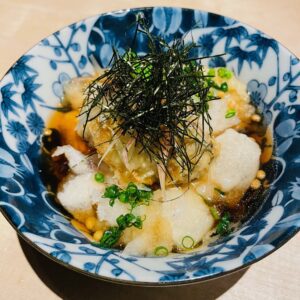
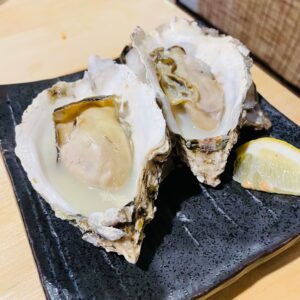
I ate Hiroshima-style okonomiyaki, “Local dishes loved by the nation,” three times. In particular, the okonomiyaki from the long-established okonomiyaki restaurant “Micchan” was excellent.
it is said that Isao Ise of “Micchan” and Zenjiro Nakamura of “Zensan” are the originators of Hiroshima-style okonomiyaki. Mitsuo Ise, who was 19 years old, took the place of Isao Ise, who was sick, and changed the store name from “Mikasaya” to Mitsuo’s nickname “Micchan”. “Micchan” contributed greatly to the development of Hiroshima-style okonomiyaki, such as offering okonomiyaki with soba as the first menu at the store.
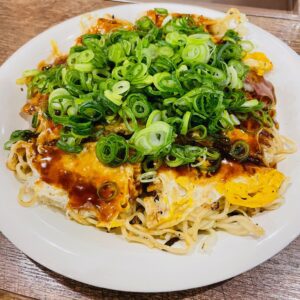
I ordered “Gansu-yaki” at “Micchan”, too. “Gansu-yaki” is a deep-fried fish paste that originated in Nishi-ku, Hiroshima City (Kusatsu) and Kure City. It is a kind of fish katsu. “Gansu” is the Hiroshima dialect of “Gozaimasu (polite language)”. It seems that it was named “Gansu-yaki” by the Kamaboko stores in Hiroshima City and Kure City with the hope that the product will grow better if you put good words on it.
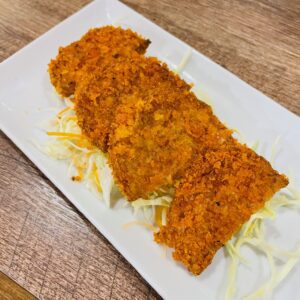
The “Deep-frying without breading or batter Kuwai (sagittaria rhizome)” I ate at “Jiyuken” in Fukuyama City was excellent. Fukuyama City is Japan’s number one producer of Kuwai, accounting for about 60% of the national production. It is said that cultivation began when the moat of Fukuyama Castle was planted from what was originally native to the swamp. I have never known that Fukuyama City is a major producer of Kuwai. By the way, the environmental image character of Fukuyama City is “Kuwai-chan”.

Since the buds of the Kuwai grow from the fruit, it can be eaten at New Year’s dishes and celebrations as a lucky charm. In fact, I’ve only eaten Kuwai as a New Year’s “Osechi dish”. The deliciousness of the “Deep-frying without breading or batter Kuwai (sagittaria rhizome)” I ate at “Jiyuken” was a pleasant surprise. It was by far the most delicious Kuwai in my life.
Kuwai has been selected as “Sweet cook Kuwai (sagittaria rhizome)” by the Ministry of Agriculture, Forestry and Fisheries in Hiroshima Prefecture’s “Our Regional Cuisines“.
Onomichi ramen is a nationally famous local ramen. The taste of ramen was one of the best ramen I ate recently. There are two types of Onomichi ramen, and Hiroshi Iwaoka, the founder of the Shin-Yokohama Ramen Museum says, “Onomichi ramen should be called Onomichi / Fukuyama ramen.” Therefore, Onomichi ramen eaten in Fukuyama City can be called local ramen.The ramen of “Onomichi Ramen Iccho” was a typical “Onomichi ramen” with a lot of fatty upper part of roast pork floating in black soy sauce soup.
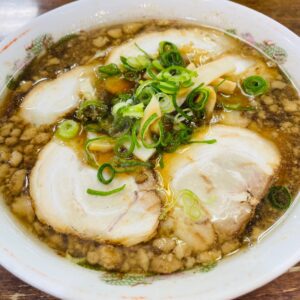
Okayama Prefecture: (Mamakari-zushi)
“100 best of local dishes” in Okayama prefecture are “Bara-zushi” and “Mamakari-zushi”. I couldn’t eat both, but I was able to eat “Mamakari’s vinegared food”, which is made by pickling Mamakari baked at “Hamayoshi” in Kurashiki City. Usually, “Vinegared Mamakari” is pickled without baking Mamakari, but although the baked Mamakari is pickled, it has the aroma unique to grilled fish and has an exquisite taste.
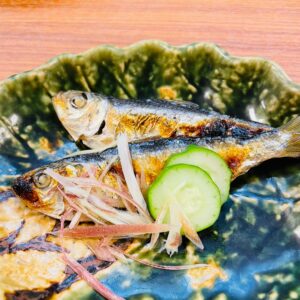
The Ministry of Agriculture, Forestry and Fisheries has selected “Vinegared Mamakari” as “Our Regional Cuisines” in Okayama prefecture. “Mamakari” is the name of Okayama prefecture, and it is a small fish called “Sappa” in the Kanto region. I have lived in Tokyo for 25 years and have never heard of a fish called “Sappa”. On the other hand, I am familiar with the fish name “Mamakari” probably because I am from Hyogo prefecture next to Okayama prefecture. I feel that the name “Mamakari” is more famous nationwide, but is it because of me? In addition, it seems that only Kagawa and Hiroshima prefectures around Okayama prefecture use “Mamakari (Japanese sardinella)” as food.
I think it’s famous, but the etymology of “Mamakari” is “I go to borrow (kari) rice (manma) next to me because it’s so delicious.” By the way, the etymology of “sappa” is said to be because it has a refreshing taste (sappari) compared to the same clupeidae, gizzard shad. In any case, the strange etymology is the fish name. In addition, it seems that “Sappa” is thrown away as a mixed small fish even if it is caught in the Kanto region.
“Ohitashi of yellow Chinese chives” is also selected as “Our Regional Cuisines” in Okayama prefecture. Yellow Chinese chives is a special product of Okayama prefecture and boasts 70% of the national production. Yellow Chinese chives is the same type of Chinese chives as ordinary Chinese chives, but the cultivation method is different. By cultivating it by blocking the light, it suppresses the generation of chlorophyll and makes it yellow, and after harvesting, it becomes bright yellow by exposing it to sunlight. Yellow Chinese chives is not addictive enough to be eaten raw and has an elegant scent. “Hamayoshi”‘s “Ohitashi of yellow Chinese chives” was very delicious.
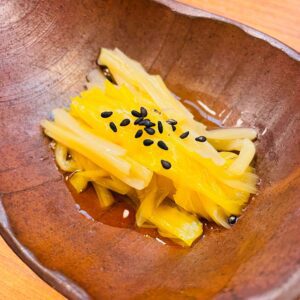
This time, I stayed in Okayama prefecture for only half a day, so I only had one meal for dinner. Next time, I would like to travel more slowly in Okayama prefecture and eat other local dishes such as “Bara-zushi” and “Mamakari-zushi”.
2. Seasonal “PRIDE FISH” by this itinerary in Japan
Hiroshima Prefecture: Hiroshima oysters, Hiroshima Red sea bream
I was able to eat Hiroshima oysters (season: January-March) and Hiroshima Red sea bream (season: March-May) from the Hiroshima “PRIDE FISH” (selected by Japan Fisheries Co-operative).
Hiroshima Prefecture has the highest production of oysters in Japan. Its production share is overwhelming at 60.4% (2020). Miyagi Prefecture is second in production, Okayama Prefecture is third, Hyogo Prefecture is fourth, and Iwate Prefecture is fifth. The picture of the oyster dish I ate is shown above, so I will omit it.
Hiroshima Red sea bream was able to be eaten as one of the “sashimi platter” at the izakaya “Umi no Kohachi” in Fukuyama City.
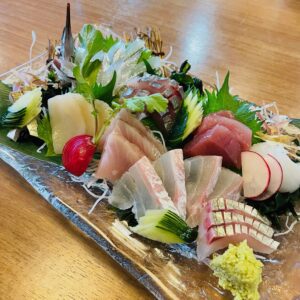
Four coastal cities in the Bingo area (Fukuyama City, Onomichi City, Mihara City by Hiroshima Prefecture, Kasaoka City by Okayama Prefecture) and fishing-related organizations are promoting the “Bingo Fish” brand. “Bingo fish” is 25 kinds of fish selected by 1,000 fishermen in Bingo. Red sea bream has been selected as the “Bingo Fish” for spring.
“fried Nebuto (cardinal fish)” is a local dish of Fukuyama city. “Nebuto (cardinal fish)” is selected for the summer “Bingo Fish”. I had “Nebuto” for the first time. It was a superb dish that goes well with beer and sake with its crispy clothes and easy-to-eat size. Cardinal fish is a white fish with a body length of about 3 to 5 cm that can be caught in the Seto Inland Sea. “Nebuto” is generally called “Indian perch”. It is said that the season is from May to September, so it may have been a little early in the end of March. However, I was very satisfied because it was very delicious.

In addition, “fried Nebuto (cardinal fish)” has been selected as “Our Regional Cuisines” in Hiroshima Prefecture by the Ministry of Agriculture, Forestry and Fisheries.
I was able to eat “Beika (Beka squid)” in Fukuyama City and Kurashiki City. “Beika” is called “chii-chii squid”. “Beika” is a small squid that is similar in size to a firefly squid, but it does not shine like a firefly squid. It is a squid with a small amount of distribution that can be eaten in limited areas such as Okayama, Hiroshima, and Kagawa prefectures in the Seto Inland Sea. The season is from spring to early summer.
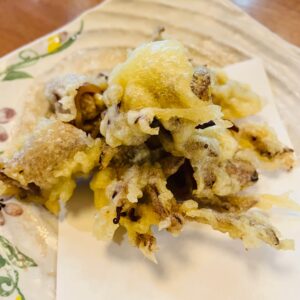
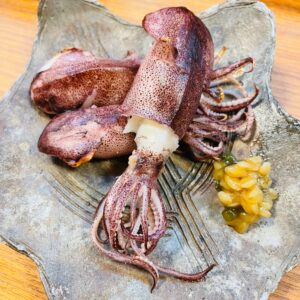
Okayama Prefecture: Spanish mackerel at Asabi, Mamakari (Japanese sardinella)
I was able to eat “Spanish mackerel at Asabi” (season: April to June) and “Mamakari (Japanese sardinella)” (season: September to November) from “PRIDE FISH” in Okayama Prefecture, which was selected by Japan Fisheries Co-operative.
Asabi is around the dawn of low tide. Previously, when Spanish mackerel was caught in Setouchi and the beaches of Bungo and Kishu, it was said that “Okayama was caught”, and most of it was shipped to the Okayama market. Okayama has the highest consumption of Spanish mackerel in spring. Okayama Spanish mackerel is mainly consumed as sashimi.
This time I visited Okayama prefecture in late March. I love Spanish mackerel sashimi, so I would like to go to Okayama from April to June, which is the season, to eat Spanish mackerel sashimi. The sashimi of Spanish mackerel I ate at “Hamayoshi” in Kurayoshi City was also very delicious.
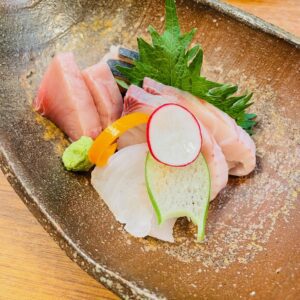
I mentioned earlier about “Mamakari”, so I will omit the details. Japan Fisheries Co-operative has set the season for “Mamakari” from September to November. On the other hand, according to the explanation of “Mamakari zushi” in “100 best of local dishes” by the Ministry of Agriculture, Forestry and Fisheries, “June before spawning is the most delicious time”. The next time I go to Okayama prefecture, I would like to ask the locals about the season of “Mamakari”.
I will omit about “Beika (Beka squid)” because I mentioned earlier about it, which is often eaten in Okayama prefecture.
3. Travel precautions for itinerary in Japan
I write the same thing every time, but it’s important, so I repeat it. This time as well, the rule of travel is an environment-friendly trip that uses only public transportation including rental bicycles.
Again, this is a reconfirmation, but traveling by public transport has far less CO2 emissions than traveling by car. For example, according to data from the Ministry of Land, Infrastructure, Transport and Tourism, CO2 emissions when one person travels 1 km are 130 g for automobiles, 98 g for aircraft (75% for automobiles), 57 g for buses (44% for automobiles), and 17 g for railways (13% for automobiles).
I didn’t have the opportunity to take a one-man operated train this time, so I was able to travel comfortably for four days without any problems.
4. Travel in a light style
Again, I sent my clothes and power cord to my accommodation in advance for this trip, and enjoyed the “luggage free trip” every day. After all, it is very easy to travel in a light style like taking a walk. Being able to act immediately after arriving by train or plane is important for effective use of time. Again, on the last day of the trip, I sent the clothes I wore during the trip to the laundry agent and did not have to do the laundry. I want everyone to experience the comfort of “luggage-free trip”.
5. March 22 (Tuesday) Day 1
It is not clear when the Fudoin was built, but it is believed that the temple existed at the end of the Heian period (794-1185). Fudoin has declined for a while, but was reconstructed by Ekei Ankokuji , a diplomatic monk of Mori and an aide to Hideyoshi Toyotomi.
On August 6, 1945, Fudoin was exposed to the atomic bomb dropped on Hiroshima City. Fudoin is located about 3.90km from the hypocenter, and although the blast caused damage such as a part of the roof of the Kondo being blown away, it survived the collapse. Fudoin became a host for A-bomb survivors, and the precincts were flooded with many injured and dead.
The Kondo, built in 1540, is a national treasure. Hiroshima City, which was devastated by the atomic bomb, has destroyed and disappeared many of its cultural properties. Fudoin, which has been minimally damaged by the atomic bomb, is the only existing national treasure in Hiroshima City. The main hall is a simple yet powerful building that clearly shows that Fudoin was a former Zen sect.
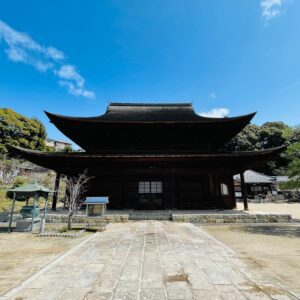
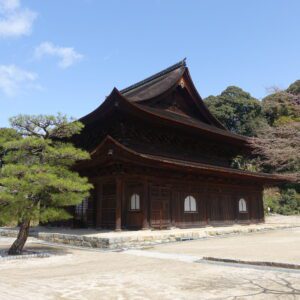
In addition to the national treasure Kondo, the tower gate (built in 1594) and the bell tower (built in 1433) are national important cultural properties. The tower gate was also a wonderful gate that is typical of the former Zen sect.
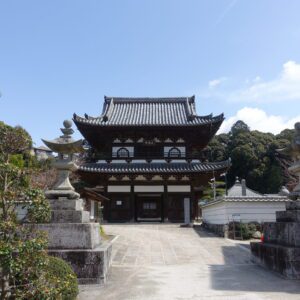
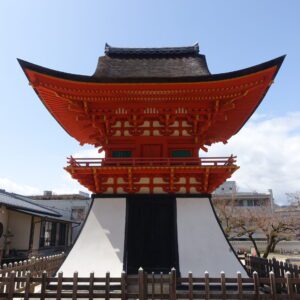
The Memorial Cathedral for World Peace is the cathedral of the Catholic Noboricho Church, which began construction on August 6, 1950 and was completed on August 6, 1954. Designed by Togo Murano, an architect who has worked on many famous buildings such as the Nissay Theater and Shin Kabukiza.
The Memorial Cathedral for World Peace was built with donations from all over the world. This construction was inspired by the idea of the German priest Hugo Makibi Enomiya-Lassalle. He came up with the idea of building a new cathedral not only to mourn the victims of the atomic bomb, but to pray for friendship and world peace around the world.
In 2006, along with the Hiroshima Peace Memorial Museum (main building) designed by Kenzo Tange, the Memorial Cathedral for World Peace was designated as a national important cultural property for the first time as a post-WWII architecture.
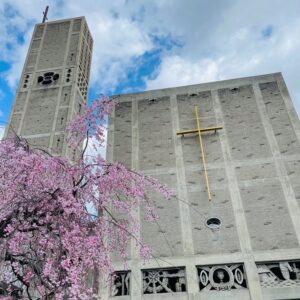

When Pope Giovanni Paolo II visited Hiroshima in 1981, he also stopped by the Memorial Cathedral for World Peace. The chair on which Giovanni Paolo II sat is still on display.

After visiting the Memorial Cathedral for World Peace, I went to Shukkeien, which is a little over 5 minutes on foot. Shukkeien is a daimyo garden completed in 1620. It originated from the villa of the feudal lord, which was ordered by Nagaakira Asano, the first feudal lord of the Hiroshima feudal clan.
The garden was designed by Soko Ueda, who was the chief retainer of the Asano family. Ueda Soko has designed many gardens such as the Tokushima Castle Omote-goten Garden and the Nagoya Castle Ninomaru Garden, and is also famous as the founder of the Ueda Soko style in the tea ceremony.
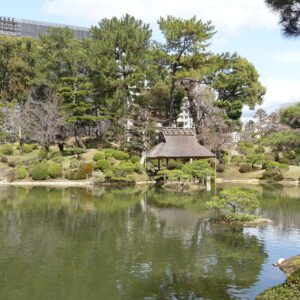

Shukkeien is a national scenic spot and has been selected as one of the 100 Best Historical Parks in Japan. It was also the time when the cherry blossoms began to bloom, and it was crowded with many people.
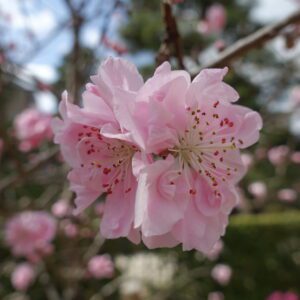
The history of Hiroshima Castle begins when Mori Terumoto entered the castle in 1591. Hiroshima Castle was incomplete when Mori Terumoto entered the castle. Finally, Hiroshima Castle was completed in 1599. At the time of completion, it was a large-scale castle with a triple moat, and it is said that it was the largest castle comparable to Osaka Castle at that time. Along with Nagoya Castle and Okayama Castle, it is counted as one of Japan’s three great castles on the plains (there is also a theory that Japan’s three great castles on the plains are Matsumoto castle, Nijo castle, and Hiroshima castle). It has also been selected as one of the Japan’s 100 Best Castles. It is also designated as a national historic site.
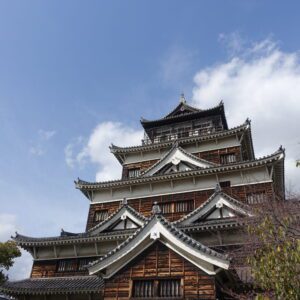
The castle tower of Hiroshima Castle collapsed due to the impact of the atomic bomb in 1945. After that, in 1958, the appearance was restored by steel-framed reinforced concrete construction. However, only the 5th floor on the top floor is made of wood. The current castle tower has a problem of earthquake resistance due to aging, and restoration by wooden construction is being considered.
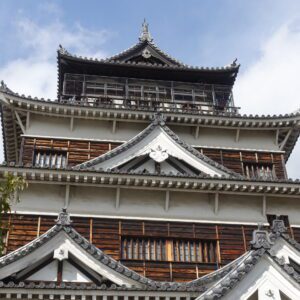
The Atomic Bomb Dome was built in 1915 as a facility for displaying and selling products in Hiroshima Prefecture. Before the bombing, it was called the Hiroshima Prefectural Industrial Promotion Center.
The Hiroshima Prefectural Industrial Promotion Center (Atomic Bomb Dome) is located 150 meters east of the hypocenter, and the blast almost completely destroyed the main body of the three-story building. However, it remained around the central dome part, the framework and the outer wall. However, all the people in the hall died instantly.
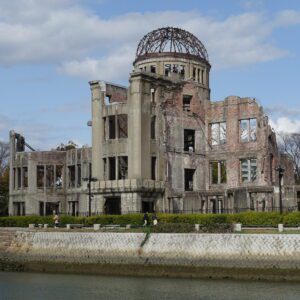
In December 1996, it was registered as a World Heritage Site as a building that conveys the devastation of nuclear weapons.
The “Children’s Peace Monument“, located just across the Motoyasu Bridge from the Atomic Bomb Dome, is modeled after Sadako Sasaki, who died at the age of 12 due to leukemia caused by the atomic bombing at the age of two. This monument was made by a fund-raising campaign by Sadako Sasaki’s classmates.
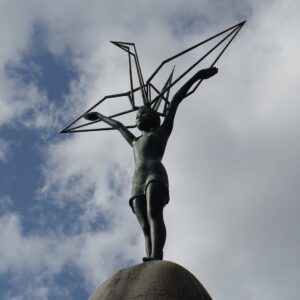
The stone monument of the statue is inscribed, “This is our cry. This is our pray. To bring peace to the world.” Many paper cranes are placed around the statue.

The Hiroshima Peace Memorial Museum, located in the same Peace Memorial Park as the “Atomic Bomb Dome” and “Children’s Peace Monument,” opened in 1955. A large number of materials affected by the atomic bomb are on display.
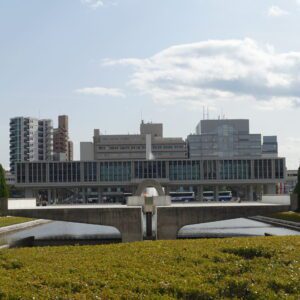
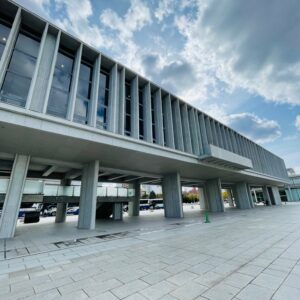
As mentioned earlier, the Hiroshima Peace Memorial Museum (main building) designed by Kenzo Tange is designated as a national important cultural property along with the Memorial Cathedral for World Peace.
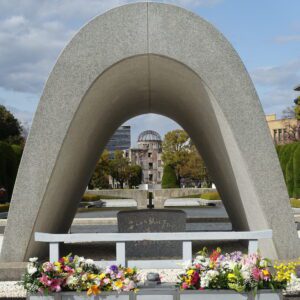
Meals
After arriving in Hiroshima city, I went to the “Denko Sekka Ekimae Hiroba store” near Hiroshima station and ate Hiroshima-style okonomiyaki. “Denko Sekka Ekimae Hiroba store” is a popular restaurant that has been selected as one of the 100 Tabelog restaurants. Unlike regular Hiroshima-style okonomiyaki, the specialty is “Denko Sekka,” which wraps the okonomiyaki dough with fluffy eggs. I ordered “Denko Sekka” (Yen 1,100).
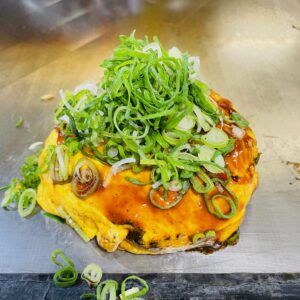
Hiroshima-style okonomiyaki is a “Local dishes loved by the nation” of Hiroshima prefecture selected by the Ministry of Agriculture, Forestry and Fisheries. The biggest feature of Hiroshima-style okonomiyaki is “Kasane-Yaki (layered grill),” which is baked without mixing the dough and ingredients.
According to the website “Prefectural Citizenship by Prefecture Statistics and Ranking”, Hiroshima Prefecture ranked first with 41.48 okonomiyaki restaurants by prefecture per 100,000 population. The number of okonomiyaki restaurants in Hiroshima prefecture is overwhelming, with 17.65 in Tokushima prefecture in 2nd place, 16.92 in Ehime and Hyogo prefectures in 3rd place, and 15.40 in Okayama prefecture in fifth place. Certainly, even if you walk in Hiroshima city, there are many okonomiyaki restaurants. It is very surprising that Osaka prefecture is not in the top five. Looking at the overwhelming number of okonomiyaki stores, it is easy to understand that the people of Hiroshima do not call it “Hiroshima-style okonomiyaki” but simply call it “okonomiyaki”.
After sightseeing in Hiroshima city, I drank blissful draft beer at “Beer Stand Shigetomi” from 17:00. I arrived at the store at 16:50, 10 minutes before the store opened. No one was lined up when I arrived, but there was a line by the opening time.
Mr. Hiroshi Shigetomi, the owner of “Beer Stand Shigetomi”, is a master of beer pouring, which is said to be a beer evangelist. At “Beer Stand Shigetomi”, Mr. Shigetomi wants to go not only to his own restaurant but also to other restaurants. Therefore, Mr. Shigetomi has decided that the business hours are only 2 hours from 17:00 to 19:00, the order is up to 2 glasses of beer, and the staying time is up to 20 minutes. At first, I thought that the store that decides these rules would be uncomfortable, but Mr. Shigetomi was a soft person and I didn’t have to worry about it in advance.
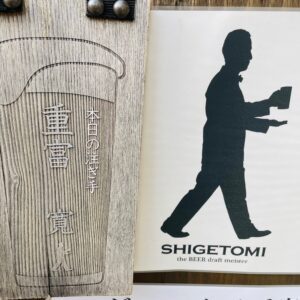
At “Beer Stand Shigetomi”, there are only standing seats with wooden barrels as tables. The beer server seems to be a modified version of an old refrigerator. When I asked Mr. Shigetomi, he said that he bought it at the auction.
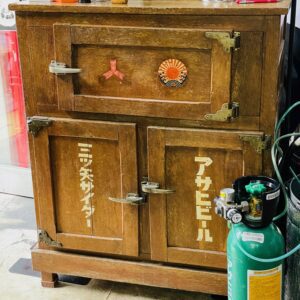
I ordered “Once pouring” for the first glass and “Sharp pouring” for the second glass. “Once pouring” is a beer that “exhilarates like running through your throat! Recommended for today’s first drink”.
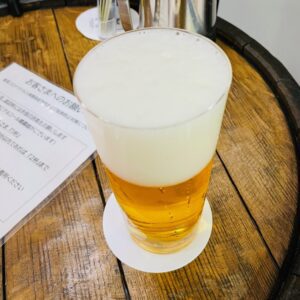
“Sharp pouring” is “a crisp and sharp taste with carbonic acid and bitterness. A miracle glass poured from two servers, Showa and Heisei.” I was impressed with the deliciousness of “Sharp pouring”, the beer foam itself was mild and delicious, and the beer had a refreshing taste and was the best mix taste.
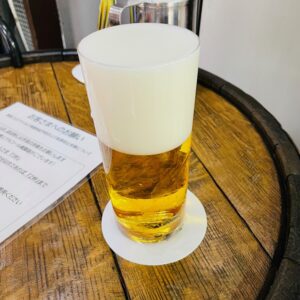
If you want to taste the skill of a master of beer pouring, “Sharp pouring” and “Mild pouring” are good. Even in the explanation of “Beer Stand Shigetomi”, only “Sharp pouring” and “Mild pouring” were written as “Beer Stand Shigetomi” original. In addition, the explanation of “Mild pouring” said, “A gentle taste that firmly suppresses carbonic acid and bitterness. Recommended for those who are not good at beer.” I like beer, so I ordered “Sharp pouring” and it was the correct answer.
In addition, there were “Twice pouring” and “Three times pouring”. The explanation of “Twice pouring” was “Add the taste of beer to the refreshing feeling of once pouring. The best balance that you will not get tired of drinking.” In addition, there was an explanation in “Three times pouring” that “By removing carbonic acid moderately, you can feel the sweetness of malt. It has a soft taste. Bubbles that rise from the glass.”
After enjoying a delicious beer at “Beer Stand Shigetomi”, I had dinner at “Takenoshita”. Everything I ordered was delicious, the service of the restaurant waitress was very good, the interior was nice and it was a very satisfying dinner.

On this day, I ordered “sashimi platter”, “sashimi of conger eel”, “pickled wasabi leaves”, “salad of Wagyu beef KOUNE meat (brisket) and small turnips”, and “deep-fried oysters in dashi broth”.
The “sashimi platter” included hairtail, flounder, octopus, Spanish mackerel, and Spindle snail. Everything was delicious, but especially the hairtail sashimi was excellent. It may have been the best hairtail sashimi of my life.
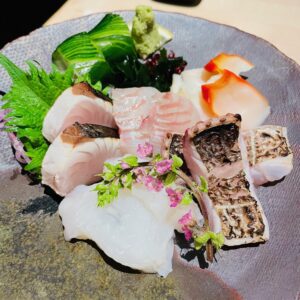
“Conger eel sashimi” was thin and beautifully presented like “Tessa (blowfish sashimi)” at first glance. The taste was excellent. In addition, the parboiled conger eel skin was a delicacy with a crunchy texture. It was great taste to wrap the parboiled conger eel skin by conger eel sashimi. It was a very memorable dish.

I ordered “Wagyu beef KOUNE meat and small turnip salad” because I was interested in “KOUNE meat”. “KOUNE meat” is a part of beef shoulder ribs, which is the meat around the side of the front legs. Also known as “Brisket”. “KOUNE meat” was found in many restaurants. “KOUNE meat” seems to be eaten quite often among the people of Hiroshima, but I haven’t seen it much outside of Hiroshima. This is a typical local dish. “KOUNE meat” was a very delicious beef that the more you chew it, the more delicious gravy oozes out.
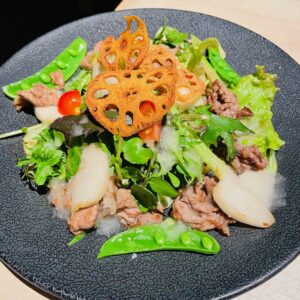
I ordered “Agedashi oysters (deep-fried oysters in dashi broth)” because I thought it would be the final stage of the season. Usually, oysters are eaten raw, grilled or fried, but deep-fried oysters are a rare way to eat them.

After having a very satisfying dinner at “Takenoshita”, I had Hiroshima-style okonomiyaki at “Henkutsuya Main Store“.
“Henkutsuya” is a historic restaurant that was founded in 1947, shortly after World War II. They started as the okonomiyaki stand. I ordered “Soba with meat” (Yen 850). The Hiroshima-style okonomiyaki of “Henkutsuya” was delicious with the old-fashioned taste. However, I wondered if the taste was a little lacking in punch.
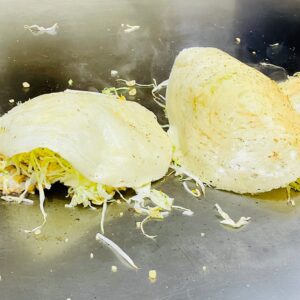
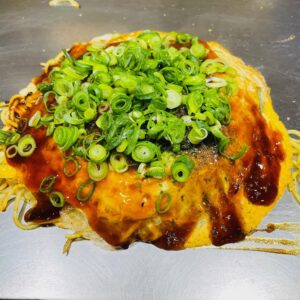
Important Points
Many of the sightseeing spots in Hiroshima are within walking distance.
When using a tram, the rear door is the entrance and the front door is the exit for one-car trains. In the case of a 3-car connected car, the rear door is the entrance and the front door is the exit for the first car. For the 2nd and 3rd cars, the 2nd door is the entrance and the 3rd door is the exit.
The fare for each Hiroshima Electric Railway (tram and bus) is Yen 190 (adults) and Yen 100 (children). Children are between 6 and 12 years old. If you ride more than 4 times a day, you can get a one-day pass of Yen 700 (adults) and Yen 350 (children). One-day tickets are sold on trains and at tram stops.
There is also a “Hiroshima Tabi Pass”. The 1-day pass (24-hour ticket) is Yen 1,000, the 2-day pass is Yen 2,000 (48-hour ticket), and the 3-day pass (72-hour ticket) is Yen 3,000. You can take all of the following transportation, Hiroshima Electric Railway (tram) lines, Miyajima route (Miyajima Matsudai Kisen, JR West Miyajima Ferry), route buses (Hiroshima Electric Railway, Hiroshima Bus, Hiroshima Kotsu, Geiyo Bus, Chugoku JR Bus, HD Nishi Hiroshima) .
There is a Japanese garden called “Sankeien” 5 minutes on foot from Hiroshima Airport. I didn’t go this time because it was raining when I arrived at Hiroshima Airport. It’s a good idea to go if you have time when you arrive or depart from Hiroshima Airport.
6. March 23 (Wednesday) Day 2
I went to Miyajima (the Island of Itsukushima) on March 23rd. Miyajima is famous as one of the three most scenic spots of Japan.

Hideyoshi Toyotomi applied for Hokoku Shrine in 1587 and ordered Terumoto Mori to build it (actually, Ekei Ankokuji built it). It was built for the memorial service of the war dead. Hokoku Shrine is the subordinate shrine of Itsukushima Shrine.
It has come to be called “Senjokaku (1,000 tatami mats palace)” because it has the size of 857 tatami mats. Indeed, the interior was quite large.
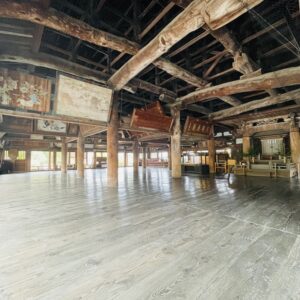
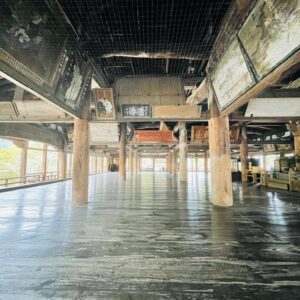
The five-storied pagoda next to Hokoku Shrine was built in 1407. The height is 27.6m. It is a beautiful five-storied pagoda that incorporates the Zen Buddhism style.
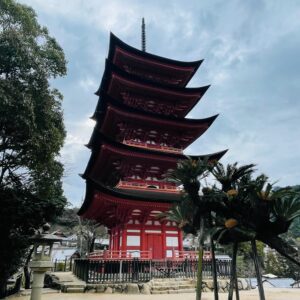
Both the Hokoku Shrine (Senjokaku) and the Five-storied Pagoda are national important cultural properties. In addition, both Hokoku Shrine and Five-storied Pagoda are registered as component monuments of the world heritage “Itsukushima Shinto Shrine”.
I took the Miyajima Ropeway and headed for the summit of Mt. Misen.
When you get off at Shishiiwa Station, which is the terminal station of Miyajima Ropeway, you will find the Shishiiwa Observatory. The view of the islands of the Seto Inland Sea from the Shishiiwa Observatory was beautiful. It was a pity that it was cloudy.
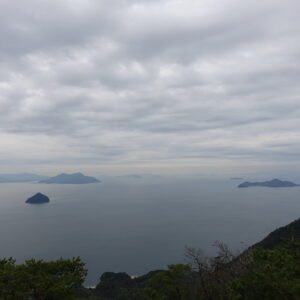
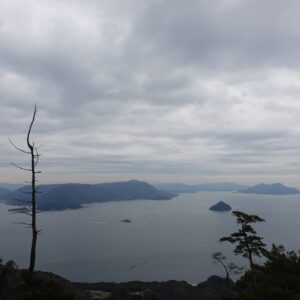
I headed to the summit of Mt. Misen from the Shishiiwa Observatory. It takes about 30 minutes to walk slowly along the mountain trail.
On the way to the summit of Mt. Misen, there is Misen-Hondo Hall and Kiezu-no-Reikado Hall. Misen-Hondo Hall is the place where Kobo Daishi built the Mido hall and practiced it for 100 days. The Daishoin Bonsho (temple bell) in the Misen-Hondo Hall was donated by Munemori Taira (the second son of Kiyomori Taira) in 1177 and is a national important cultural property.
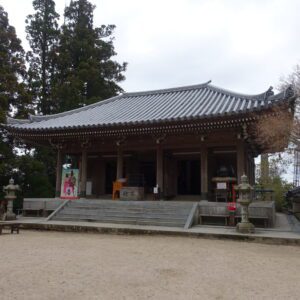
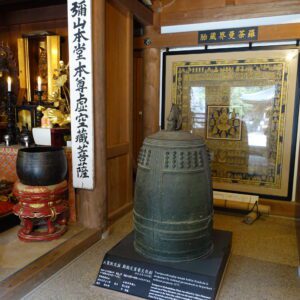
There was a pair of deer in the garden in front of Misen-Hondo Hall.
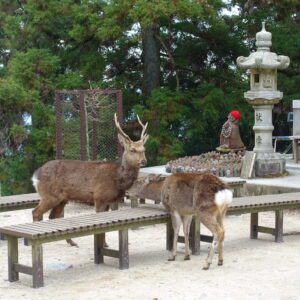
In Kiezu-no-Reikado Hall, the spiritual fire that Kobo Daishi practiced in 806 is still burning as “Kiezu no Hi (Eternal Flame)”.
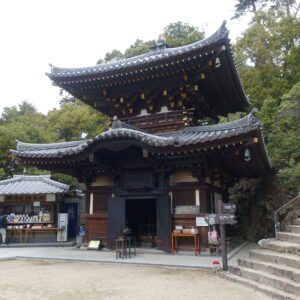
There are Kuguri-iwa Rock and Fudo-iwa Rock just a short walk from Monju-do Hall and Kannon-do Hall.
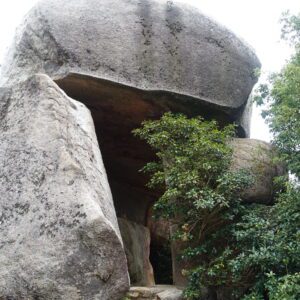
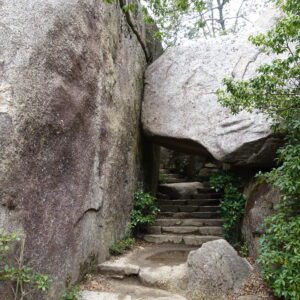
If you go through the Kuguri-iwa Rock, you will soon reach the summit of Mt. Misen (elevation 535 m). There are megaliths on the summit of Mt. Misen, and these megaliths are thought to be Iwakura. Iwakura is a rock where a god dwells. Mt. Misen was a mountain of mountain worship that targets Iwakura as a ritual.

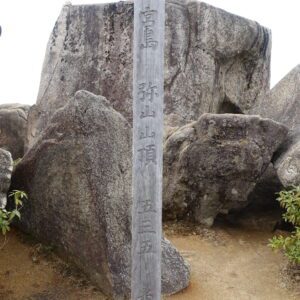
The view from the summit of Mt. Misen was also very beautiful. It was a pity that it was cloudy. Hirobumi Ito praised “The true value of one of the three most scenic spots in Japan lies in the view of the summit.”
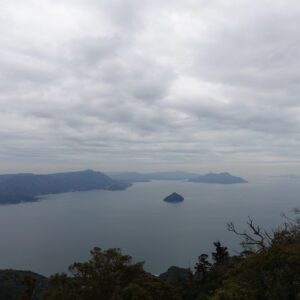
Daishoin is the oldest temple in Miyajima. It is said that after Kukai (Kobo Daishi) returned from Tang, he went to Miyajima and practiced at Mt. Misen, and opened the Daishoin in 806.
There are many temples such as Niomon, Onarimon, Chokugan-do, Kannon-do, Mani-den, and Daishido in Daishoin Temple, and it was a valuable experience just to visit each of them. I regret not visiting the Henjo-kutsu Cave in the basement of Daishido this time.


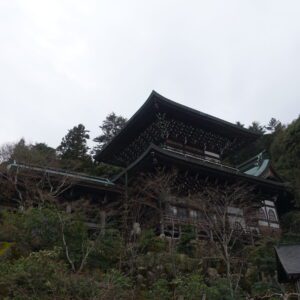
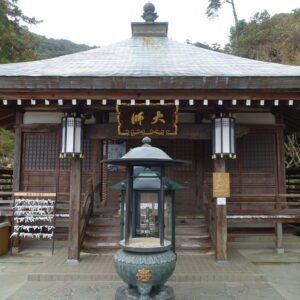
In particular, I enjoyed walking while watching the Gohyaku-rakan (Five Hundred Disciples of the Buddha) wearing red hats.

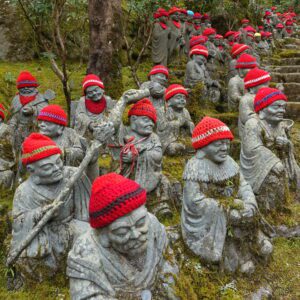
Many Hina dolls were displayed in the Kannon-do.
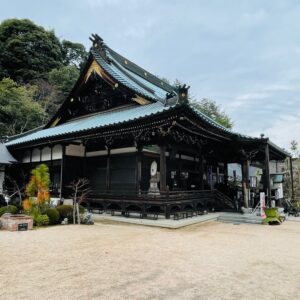
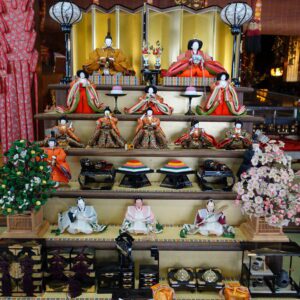
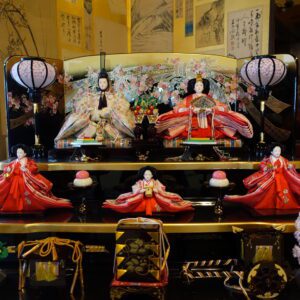
After visiting the Daishoin Temple, I had lunch and went to Itsukushima Shrine. 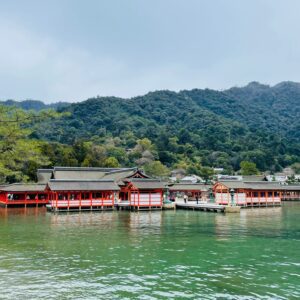
Itsukushima Shrine begins in 593 when Kuramoto Saeki, a local lord of the region, built a shrine dedicated to Ichikishimahime. The large shrine that stands on the sea today was set up by Kiyomori Taira. However, the shrine built by Kiyomori Taira was destroyed by fire, and the remaining shrine was built after 1240-1243.
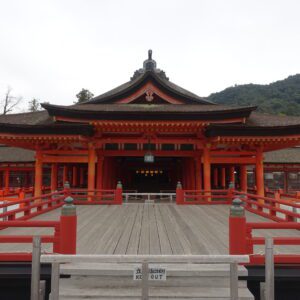
Itsukushima Shrine and subordinate shrines are registered and designated as a World Heritage Site, national treasures, and national important cultural properties.
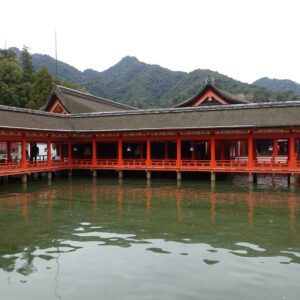
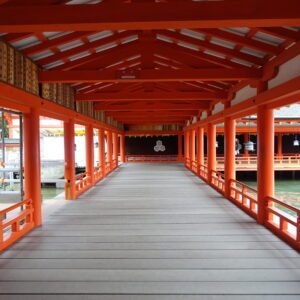
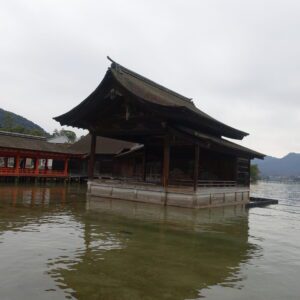
The 16m high wooden O-torii that stands on the sea is one of the three major torii in Japan (the others are Yoshino Kinpusenji Temple copper torii and Osaka Shitennoji Temple stone torii) and is a national important cultural property. It was a pity that it was not seen during the repair work now. The end date of the O-torii repair is undecided.
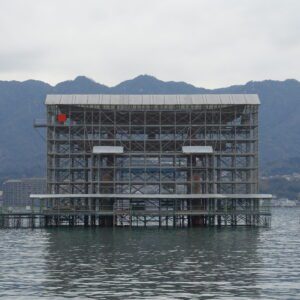
This time, I couldn’t go to the Tahoto, which belongs to Itsukushima Shrine, because it started to rain. However, the Tahoto could be seen from the precincts of Daiganji Temple. The Tahoto is a national important cultural property.
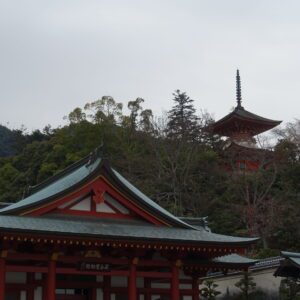
After arriving at Hiroshima Station, I went to Kokuzenji Temple, which is about a 10-minute walk away.
Kokuzenji Temple was opened in 1340 by Nichizo Shonin. In 1656, it became the Bodhisattva Temple of the Asano family due to the conversion of legal wife, Mitsuhime of Mitsuakira Asano. Mitsuakira was the second feudal lord of the Hiroshima domain. The main hall was built in 1671. It is estimated that the back of the warehouse was built at the same time. Both the main hall and the back of the warehouse were built by a castle carpenter of the Hiroshima domain, and are characterized by the use of castle construction techniques.
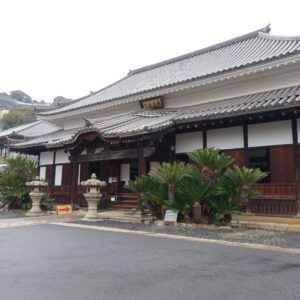
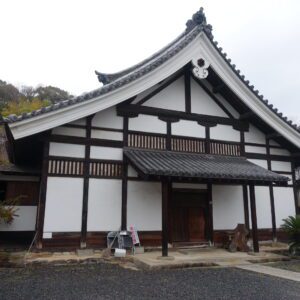
The main hall and the back of the warehouse are designated as national important cultural properties. There are only four national important cultural properties (buildings) in Hiroshima City: Fudoin Temple (which is also a national treasure), the Memorial Cathedral for World Peace, the Hiroshima Peace Memorial Museum, and the Kokuzenji Temple. In addition, Fudoin Temple and Kokuzenji Temple are the only national important cultural properties that were built before the atomic bombing.
The gate of Kokuzenji Temple is a cultural property designated by Hiroshima City.
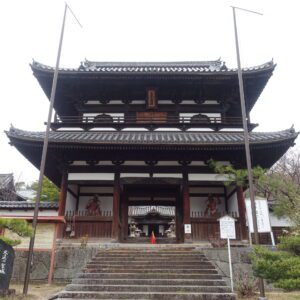
Meals
I drank “Mt. Misen Dragon IPA” at “MIYAJIMA BREWERY“. I like IPA beer. The IPA of “MIYAJIMA BREWERY” was also a very delicious beer. In addition to IPA, there are various types such as “HIROSHIMA RED ALE”, so I would like to try various things the next time I visit Miyajima.
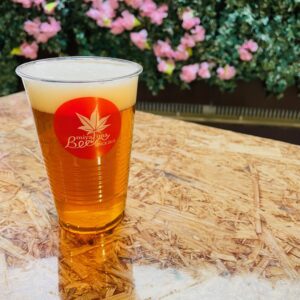
“MIYAJIMA BREWERY” is the only brewery in Miyajima. “MIYAJIMA BREWERY” has a stand bar and brewery on the first floor and a restaurant on the third floor. The restaurant on the 3rd floor was closed at the time of my visit.
For dinner, I had an excellent dish at “Izakaya Shin”. I ordered “Sashimi platter”, “Potato and dried young sardines salad”, “Grilled soft milt of cod with kelp”, and “Conger eel tempura” at “Izakaya Shin”.
The “sashimi platter” contained conger eel, soft milt of cod, Spanish mackerel, mantis shrimp, tuna, and bonito. All were very delicious. Especially, the mantis shrimp and the Spanish mackerel were delicious.
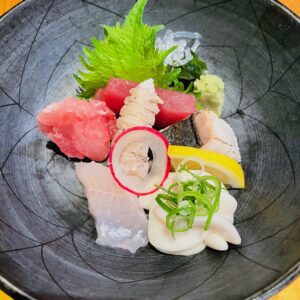
“Grilled soft milt of cod with kelp” was a masterpiece that you can feel the stickiness different from the sashimi of milt. The taste of kelp was transferred to milt, and I enjoyed it with sake from Hiroshima.
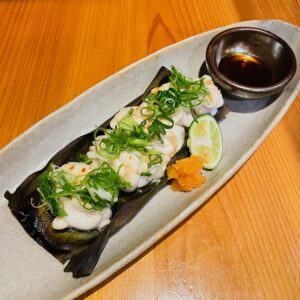
“Conger eel tempura” was excellent with a crispy texture. I was able to eat conger eel tempura for both lunch and dinner. Conger eel tempura is my favorite. In particular, I like the style of eating conger eel tempura with salt instead of ten-tsuyu (thin dipping sauce for tempura). I ate conger eel tempura with salt on this day as well.
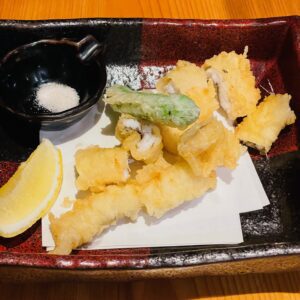
I wasn’t completely satisfied with the Hiroshima-style okonomiyaki I ate the day before, so I decided to eat Hiroshima-style okonomiyaki at Micchan, which was delicious on my last trip to Hiroshima.
The “Micchan” I visited this time is the “Micchan Sohonten Hatchobori Main Store”. I went to the store after 19:00, but there was already a line and I lined up for almost 30 minutes. As expected, the popularity of “Micchan” is amazing. “Micchan Sohonten Hatchobori Main Store” is the first store of “Micchan Sohonten”. It is also one of the 100 famous tabelog restaurants.
“OKONOMI-YAKI Chinese Noodles” of “Micchan” was the best. After all, it has a different impression from other okonomiyaki restaurants. The texture of the fluffy cabbage is also the best.

Mayonnaise is placed on the table at “Micchan”, so you can freely apply mayonnaise on the okonomiyaki. Generally, mayonnaise is used only in the Kansai region, and there is a tendency not to use it in Hiroshima-style okonomiyaki. In fact, neither the “Denko Sekka” nor the “Henkutsuya” I ate the day before had mayonnaise. I prefer to use mayonnaise because I hope it tastes good.
Important Points
You can also go from Hiroshima Station to Miyajimaguchi Station by Hiroshima Electric Railway (tram), but it takes about 1 hour and 10 minutes. It will save you time if you take JR West, which takes less than 30 minutes from Hiroshima Station to Miyajimaguchi Station.
7. March 24 (Thursday) Day 3
On the morning of March 24, I took a bus from Hiroshima Station to the “Takehara Preservation District of Important Historical Buildings”.
“Takehara Preservation District of Important Historical Buildings” has been selected by the government as Preservation Districts for Groups of Traditional Buildings. Takehara prospered as a mansion of Shimogammo Shrine in Kyoto during the Heian period (794-1185). Takehara is called “Little Kyoto of Aki” because of its historical relationship with Kyoto. It developed as a salt-making area during the Edo period.
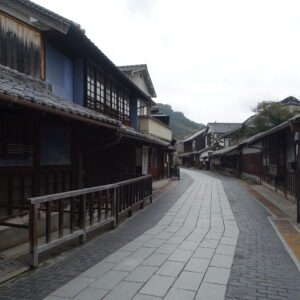
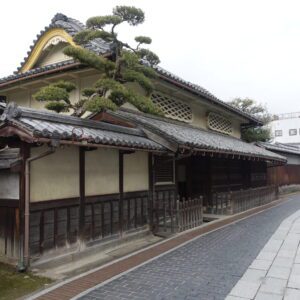
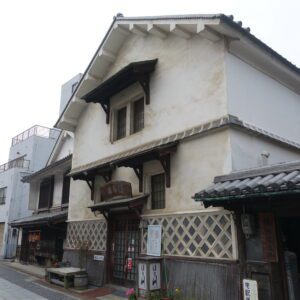
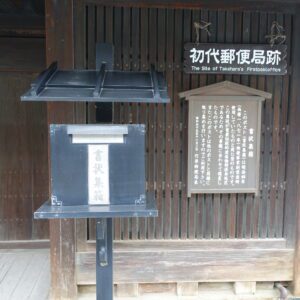
Even today, the streets of the Edo period still remain in Takehara, giving it a calm atmosphere.

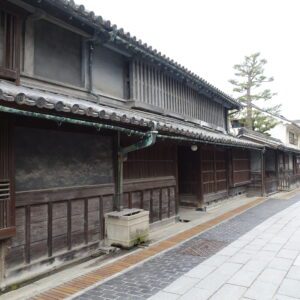
Taketsuru Sake Brewery is located in the “Takehara Preservation District of Important Historical Buildings”. The birthplace of Masataka Taketsuru, the founder of Nikka Whiskey and known as the “father of Japanese whiskey.” The whiskey “Taketsuru Pure Malt” is popular all over the world and is in short supply. I also love “Taketsuru Pure Malt” whiskey.
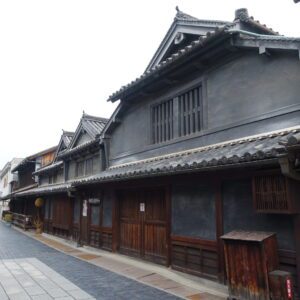
Taketsuru Sake Brewery is a long-established sake brewery founded in 1733, and still makes sake under the name of “Kosasa-ya”.
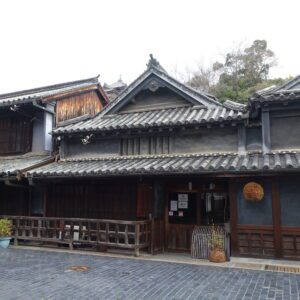
I went from “Roadside Station” in Takehara to Onomichi Station. After arriving at Onomichi Station, I had lunch and strolled at the Onomichi Hondori shopping street.
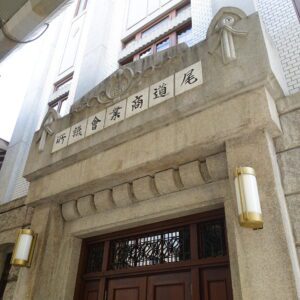
Onomichi Hondori Shopping Street is one of the longest shopping streets in Japan with a total length of about 1.2km, and there are about 210 stores along the shopping street. There are more than 10 long-established stores that have been in business for over 100 years, and it was fun to take a walk in the shopping district while looking at the old buildings.
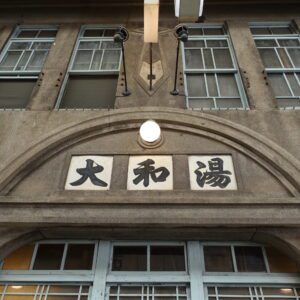
The former Onomichi City Branch Office, located on a street slightly off the Onomichi Hondori shopping street, was originally the Onomichi Branch of Sumitomo Bank. It was built in 1904.
Designed by Magoichi Noguchi, a disciple of Kingo Tatsuno who designed the Marunouchi station building at Tokyo Station and the Bank of Japan Head Office. Magoichi Noguchi designed the Osaka Prefectural Nakanoshima Library, which is an important cultural property of Japan. The former Onomichi City Branch Office features a very unique window stone design.
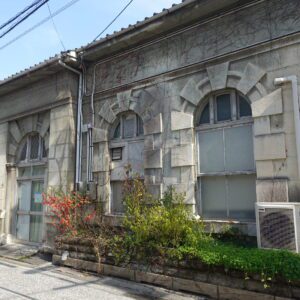
After enjoying a walk in the Onomichi Hondori shopping street, I went to Tenneiji Temple. Tenneiji Temple was founded in 1367. The second shogun, Yoshiakira Ashikaga, the son of Takauji Ashikaga, the first shogun of the Muromachi Shogunate, built a five-storied pagoda in 1388. The third shogun, Yoshimitsu Ashikaga, stayed at Tenneiji Temple in 1389 and it has a close relationship with the Ashikaga Shogunate.
Since the five-storied pagoda became obsolete in 1692, the upper two layers were removed to make it the current three-storied pagoda (about 20 m in height). The three-storied pagoda is a national important cultural property. The scenery seen from the slope above the three-storied pagoda is one of the representative scenery of Onomichi.
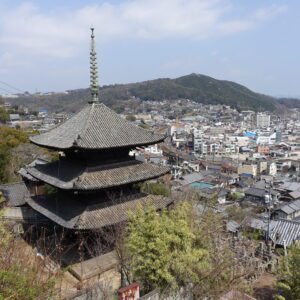
The peony and lion “Fusuma-e” are the work of Gyokusei Jikihara, an authority in the Japanese Nanga. I was overwhelmed by the vigorous painting of the lion.
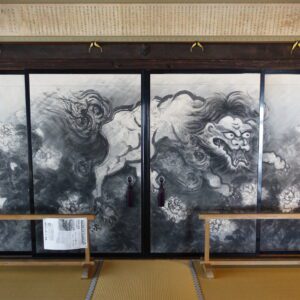
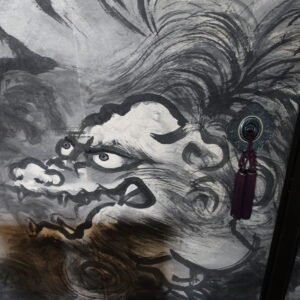
I was overwhelmed by the Statues of the 500 Rakans of Tenneiji Temple. Unlike the cute 500 Rakan wearing the red hat of Daishoin in Miyajima, which I went to the day before, the 500 Rakan of Tenneiji Temple had a solemn atmosphere.
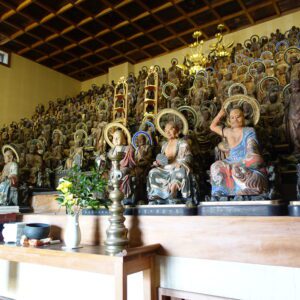
According to the temple, Saikokuji Temple was built in 729 by Gyoki. This is the headquarters of the Shingon sect Daigo school. It became Emperor Shirakawa’s Chokuganji-temple (temple built at the order of the emperor) in 1108 and was proud of the biggest Buddhist temple in the Sanyo region. It is still the largest temple in Onomichi City.
Deva gate is an important cultural property designated by Hiroshima Prefecture. It was built in 1648. 2m large straw sandals are hung, hoping for good legs. I was quite surprised at the size of these large straw sandals.
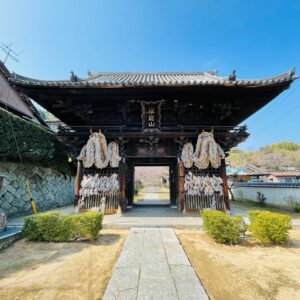
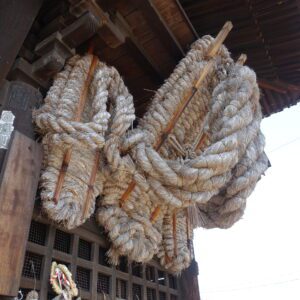
The Kondo, which was built in 1386 by Mr. Yamana, the guardian of Bingo, is designated as a national important cultural property. It remains so beautiful that it doesn’t look like it was built over 600 years ago.
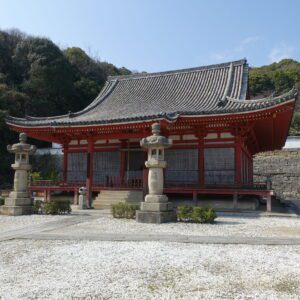

The three-storied pagoda was built in 1429 with the donation of Yoshinori Ashikaga, the sixth shogun of the Muromachi Shogunate. It has remained beautiful at the time of its construction without a fire. The three-storied pagoda is a national important cultural property. The view of Onomichi from the location of the three-storied pagoda is very beautiful.
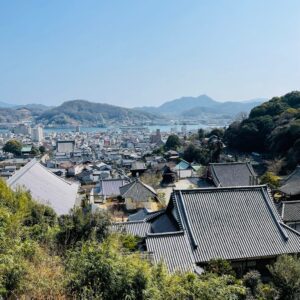
Saigoji Temple was built in 1353 with a donation from Takauji Ashikaga. The main hall best represents the architectural style of the Northern and Southern Dynasties, and is considered to be the remains of the oldest main hall of Ji-shu sect of Buddhism. The main hall and the temple gate are national important cultural properties.
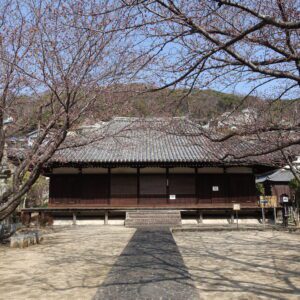
Jodoji Temple is a headquarters temple of Shingon sect Senyuji school. It is said that Prince Shotoku was founded in 616. It is also famous as a temple where Takauji Ashikaga prayed for victory during the battles of Kyushu Campaign and Minatogawa.
The main hall and Tahoto (two-storied pagoda) of Jodoji Temple are national treasures.
The main hall was built in 1327 and is a masterpiece of medieval Setchuyo Buddhist temple architecture. Setchuyo style is an eclectic style of Japanese style architecture, Daibutsu style architecture, and Zenshu style architecture.
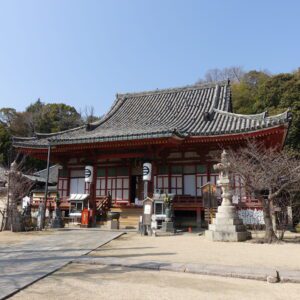
The Tahoto (two-storied pagoda) was built in 1328. As a Tahoto, it is one of the six national treasures in Japan as Tahoto. The form of the Tahoto is different from the five-storied pagoda and the three-storied pagoda, and is unique to Japan. The Tahoto is a tower in which the first layer with a square plane and the upper layer with a circular plane are layered.
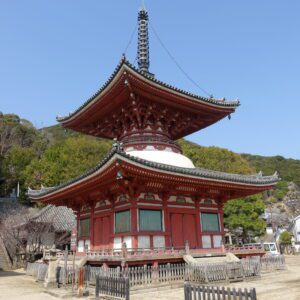
Jodoji Temple has many national important cultural properties such as temple gate and Amida-do (temple hall containing an enshrined image of Amitabha).
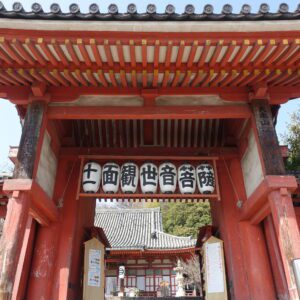
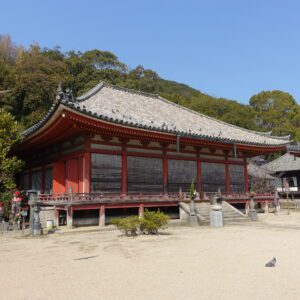
It is said that homing pigeons were kept at the “Uramon (back gate)” during the Edo period, and there are still many pigeons in the precincts. You can also buy pigeon food for Yen 30 and give it to the pigeon. Although it is a wild pigeon, when you put food on your hands, the pigeon is so accustomed to people that it stays on your hands and shoulders. The “Uramon” is also a national important cultural property.
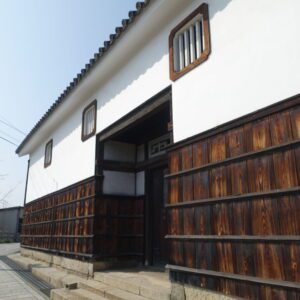
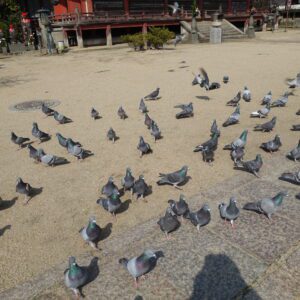
When you arrive at Fukuyama Station, you can see Fukuyama Castle from Platform 6. However, the castle tower (inside the Fukuyama Castle Museum) has been closed for a long time until August 27, 2022 due to a large-scale renovation. The castle tower was rebuilt in 1966 with a reinforced concrete structure.
The Fushimi turret on the left side of the platform of Fukuyama station is a three-story corner turret. It was relocated in 1620 from the eastern turret of Matsunomaru, Fushimi Castle in Kyoto, which is estimated to have been built around 1601. When Katsunari Mizuno built Fukuyama Castle, Hidetada, the second shogun of Tokugawa, relocated it. The Fushimi turret is one of the oldest surviving turrets along with the Kumamoto Castle Uto turret.
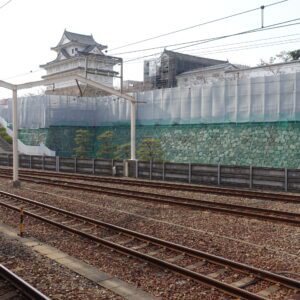
In the 1945 Fukuyama air raid, the area around the Fushimi turret escaped fire and became the only existing turret in Fukuyama Castle. It is designated as a national important cultural property.
Meals
After enjoying a walk in the “Takehara Preservation District of Important Historical Buildings”, I drank FUKUBEER at “Roadside Station Takehara”. FUKUBEER is a golden ale containing honey from “FUKUBEE”, which runs an apiary in Tanoura, Takehara City. It is a collaboration product of “FUKUBEE” and Iwami Bakushu in Iwami City, Iwate Prefecture. Although it is a beer, it contains honey, so it was a beer with a gentle taste that was perfect for drinking in the morning.
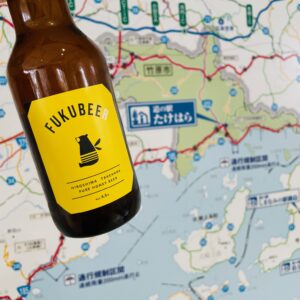
After arriving at Onomichi Station, I ate Onomichi ramen at “Kukai“. Onomichi ramen is a local ramen that is famous nationwide for its soy sauce-based soup with fatty upper part of roast pork and flat noodles.

The Onomichi ramen of “Kukai” was delicious with a gentle taste. However, I wondered if the noodles were a little soft. The owner was very polite and kind.
While walking around Onomichi, I took a break at “Onomichi Roman Coffee” in the Onomichi Hondori shopping street. The interior of the coffee shop is classical and has a nostalgic atmosphere.
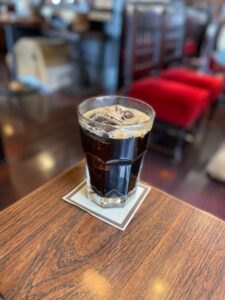
“Omichi Roman Coffee” is a home-roasted coffee shop where coffee brought by siphon is poured into a glass filled with ice in front of customers. It was a very strong and delicious coffee because it was for two cups of coffee.
After arriving at Fukuyama Station and checking in at the hotel, I had dinner at the izakaya “Umi no Kohachi”. “Umi no Kohachi” is located under the elevated railway tracks at Fukuyama Station.
I ordered “Assorted sashimi”, “pickled mantis shrimp”, “fried Nebuto (cardinal fish)”, and “small squid tempura” at “Umi no Kohachi”.
The “sashimi platter” was beautifully presented with many types of sashimi, centered on halfbeak and red sea bream, which are in season in spring. It was delicious sashimi.


“Pickled mantis shrimp” is a fresh seasonal mantis shrimp caught in the Seto Inland Sea, and was a delicious gem that goes well with sake. The season of mantis shrimp is twice a year, March-April and September-October.
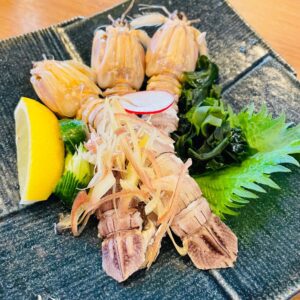
The exquisite dish was “fried Nebuto (cardinal fish)”. It was a superb dish that goes well with beer and sake with its crispy clothes and easy-to-eat size. Cardinal fish is a white fish with a body length of about 3 to 5 cm that can be caught in the Seto Inland Sea. “Nebuto” is generally called “Indian perch”. It is said that the season is from May to September, so it may have been a little early in the end of March. However, I was very satisfied because it was very delicious.

After “Umi no Kohachi”, I drank again at “Jiyuken”. “Jiyuken” is a restaurant and izakaya that is loved by locals. It was very crowded when I visited.
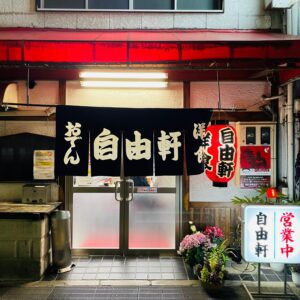
I had “Oden”, “stir-fried liver and Chinese chives” and “Deep-frying without breading or batter Kuwai (sagittaria rhizome)” at “Jiyuken”.
“Oden” in “Jiyuken” was covered with sweet miso. It was a little too sweet for me.
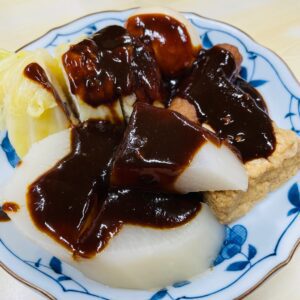
The exquisite dish was “Deep-frying without breading or batter Kuwai (sagittaria rhizome)”. 
Important Points
There are few restaurants in the “Takehara Preservation District of Important Historical Buildings”, so it’s a good idea to shop, eat and drink at the nearby “Roadside Station”.“Roadside Station Takehara” sells a lot of locally grown vegetables, and many Takehara citizens enjoyed shopping even in the morning. I liked the bright and clean building of “Roadside Station Takehara”. Before and after walking around the “Takehara Preservation District of Important Historical Buildings”, we recommend this “Roadside Station” to tourists.
Sightseeing at Onomichi Station is basically on foot. When you go around the temples, the distance between the temples is about 10 minutes, so the distance is just right. However, the cumulative walking time will be longer, so I think that people with weak legs should visit the temples near Onomichi Station. Or you can take a bus or taxi just one way.
8. March 25 (Friday) Day 4
I went to Tomonoura by bus from Fukuyama Station on the morning of March 25.
Tomonoura is an old town that has been a village since ancient times, with eight songs about Tomonoura in the Manyoshu (759). It is also the place where Takauji Ashikaga was given a decree by Ex-emperor Kogon in Tomonoura on his way to Kyoto.
Yoshiaki Ashikaga, the 15th shogun of the Muromachi Shogunate, who was exiled from Kyoto by Nobunaga Oda, moved to Tomo in 1576 with other samurai families of the Shogunate. It was called “Tomo Shogunate”.
For this reason, the historian Rai Sanyo at the end of the Tokugawa shogunate likened that “Ashikaga (Muromachi Shogunate) was born in Tomo and perished in Tomo.” In addition, it was a town that prospered during the Edo period as a “port for waiting for the tide.”
Tomonoura has been selected as a “National Preservation Districts for Groups of Traditional Buildings” as a “Tomocho Traditional Buildings Preservation District in Fukuyama City”. Also, at “Ponyo” released in 2008, director Hayao Miyazaki stayed for two months and became famous as a place where he devised a plan of “Ponyo”.
The stone light house is a symbol of Tomonoura. Built in 1859. The stone light house is over 10m in size and is the tallest stone light house in Japan as a port stone light house.
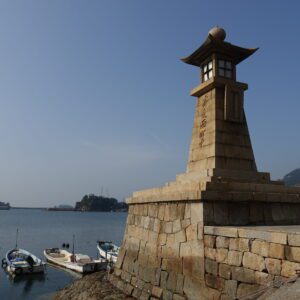
In addition, Tomonoura is the only ports in Japan to keep the port facilities of the Edo period (19th century) such as stone steps for landing goods in high or low tide, a sea wall, a shipping watch-house and an area for repairing ships.
The “Ota Family Residence” near the stone light house and Irohamaru Exhibition Hall is a former “Homei-shu” liquor store. It is designated as a national important cultural property because it is a well-preserved sake brewery, a merchant house in the Edo period that represents the Seto Inland Sea.
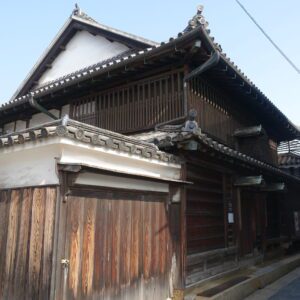
The “Ota Family Residence” was used as a place to stay when seven courtiers, including Sanjo Sanetomi when they ran away to Choshu in 1863 and when they came back to Kyoto in 1864. They were the Sonno Joi faction (those who advocated reverence for the Emperor and expulsion of foreigners).
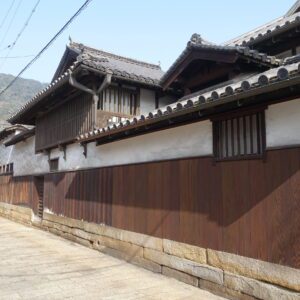
The “Homei-shu” liquor store “Tomo Sake Brewery Co., Ltd.” still operates in a place slightly away from “Ota Family Residence”. It was a wonderful house with a personality. There are several sake breweries in Tomonoura that make “Homei-shu”.
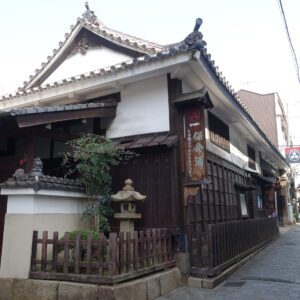

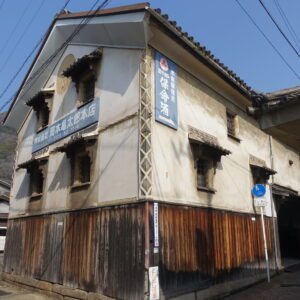
Nunakuma Shrine was renamed “Nunakuma Shrine” by enshrining Watasu Shrine and Tomogi-Ongu in the Meiji era. According to the shrine, regarding the construction of Watasu Shrine, when Empress Jingu headed to Saigoku in 193 AD, he worshiped Watatsumi on the local spirit stone and prayed for the safety of the sea route. On the other hand, the origin of Tomogi-Ongu is unknown. Tomogi-Ongu is said to be the head office of Yasaka Shrine in Kyoto.
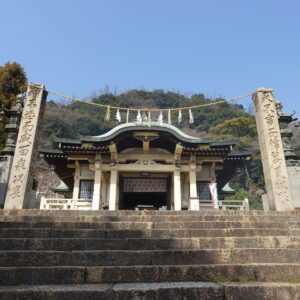
There is the Noh stage of the Azuchi-Momoyama period below the main shrine of Nunakuma Shrine. Originally located in Fushimi Castle, it is a prefabricated stage that Hideyoshi Toyotomi also used. This Noh stage was worshiped by the second shogun, Hidetada Tokugawa, by Katsushige Mizuno, the lord of Fukuyama Castle, and donated to Nunakuma Shrine. The assembled Noh stage is the only existing one in Japan. It is a national important cultural property. We cannot see the inside.
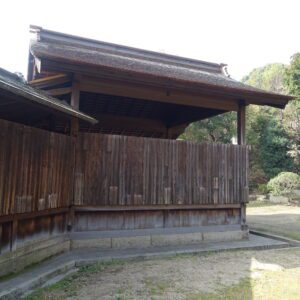
If you walk about 5 minutes from Nunakuma Shrine, you will find Ankokuji Temple. Ankokuji Temple was founded in 1273 as Kinpoji Temple (predecessor of Ankokuji Temple) with Muhon Kakushin (Hoto Kokushi) as the founder. The Shakado and the wooden Amida Nyorai (Amitabha Tathagata) are national important cultural properties.
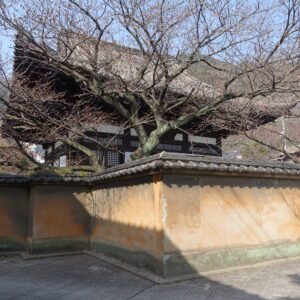
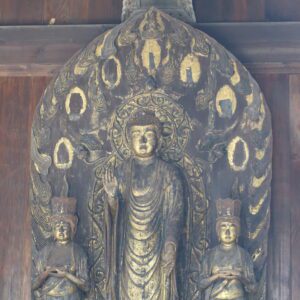
Ryoma Sakamoto and others who visited Tomonoura stayed at Masuya Seiemon’s house during the “Iroha Maru Incident”. It is said that Ryoma Sakamoto was hiding in the hidden space behind the ceiling of Masuya Seiemon house. Ryoma Sakamoto stayed in 1867, about seven months before he was killed in Kyoto.
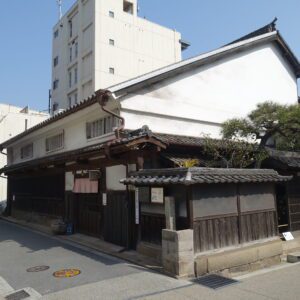
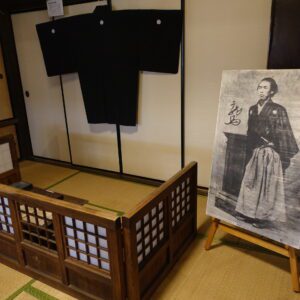

“Fukuzenji Temple, Taichoro” is the highlight of Tomonoura sightseeing. “Fukuzenji Temple, Taichoro” is designated as a national historic site. Fukuzenji Temple is said to have been built as “Kannon-do” (Tendai sect) by Kuya Shonin around 950. Taichoro was built in 1694.
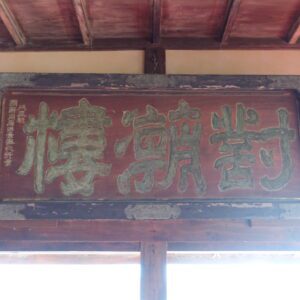
Taichoro was used as a guesthouse for the Joseon missions to Japan. The officer, Li Bangyan in the 8th Joseon missions in 1711 admired the view of Tomonoura seen from Taichoro as “Nitto Daiichi Keisho” ( It means the most scenic place in the world east of Korea). The one with this sentence on the forehead is listed in Taichoro. In addition, the view photograph from Taichoro was also used for the CD jacket of Shinji Tanimura’s “Good Day Departure (Cover of Momoe Yamaguchi)”.
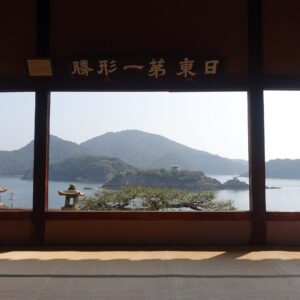
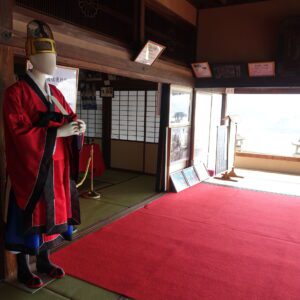
Fukuzenji Temple also became a forum for negotiations between the Kaientai by Ryoma Sakamoto and the Kishu Domain during the “Iroha Maru Incident.”
Bandaiji Temple, Abuto Kannon is located about 4km away from Tomonoura.
観音-300x300.jpg)
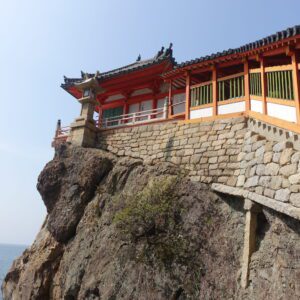
Bandaiji Temple was built in 992 by Emperor Kazan to enshrine the stone eleven-faced Kannon statue as the principal image and pray for the safety of the voyage in the vicinity. In 1185, it was damaged by the Genpei War. Kannon-do was founded by Terumoto Mori in 1570 and has been designated as a national important cultural property.
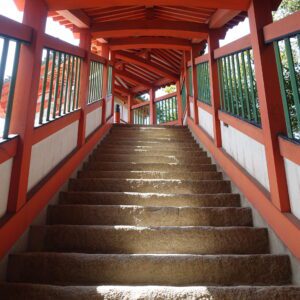
Kannon-do is often featured in paintings such as Ukiyo-e by Hiroshige Utagawa because of its beauty.
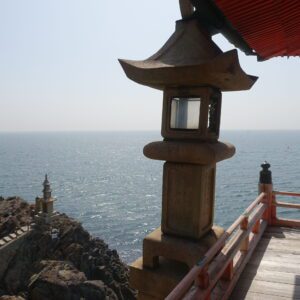
Myooin Temple was founded by Kobo Daishi in 807 as Jofukuji Temple.
The main hall and five-storied pagoda of Myooin Temple are national treasures.
The main hall was built in 1321. It is considered to be a typical example of Setchu-yo (mixed architecture style between the Great Buddha style and Zen sect style to traditional Japanese style).
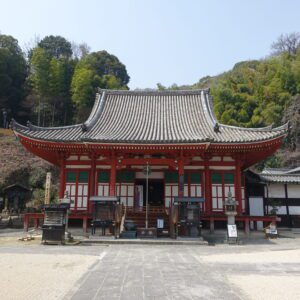
The five-storied pagoda is a pure Japanese style pagoda built in 1348. It is a very beautiful tower with a height of 29 meters. This five-storied pagoda is the fifth oldest pagoda in Japan.
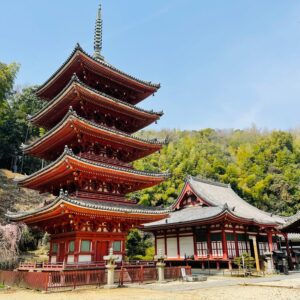
Kusado Sengen Town is a medieval archaeological site buried in the Ashida River. Relics excavated from the ruins are preserved and exhibited at the Hiroshima Prefectural Museum of History in Fukuyama City. The excavated relics are designated as national important cultural properties.
Kusado Inari Shrine is next to Myooin Temple. Kusado Inari Shrine is said to have been enshrined by Kukai in 807 as a guardian of Myooin Temple (at that time, Jofukuji Temple). Kusado Inari Shrine is called “Top 5 Japanese Inari Shrines in the Kyoto Fushimi Inari family”.
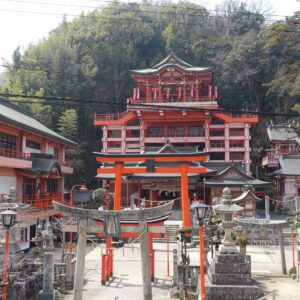
Originally, the main shrine of Kusado Inari Shrine was enshrined in the sandbar of the Ashida River. Katsusada Mizuno, the third lord of Fukuyama domain moved the shrine to the present location in 1655.

The current main shrine was relocated on a concrete structure at the end of the Showa period. You can enjoy a wonderful view from the main shrine.
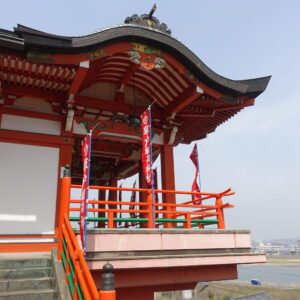

After arriving at Kurashiki station, I went to the Ohashi family residence, which is about a 10-minute walk. The Ohashi family residence is located a little away from the “Kurashiki Bikan Historical Quarter”.
The Ohashi family residence was built between 1796 and 1799. It has a unique architectural style of Kurashiki such as roof tiles and Kurashiki lattice on the white wall. It is designated as a national important cultural property.
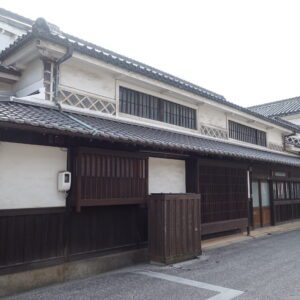
The Ohara Museum of Art Shin-Kojima-Kan (provisional name) is Kurashiki’s first full-scale Western-style building built in 1922. Originally it was the Daiichi Joint Bank Kurashiki Branch and the Chugoku Bank’s Kurashiki Hommachi Branch Office. It is a nationally registered tangible cultural property. Designed by Kazue Yakushiji, who designed the Ohara Museum of Art and Kurabo Central Hospital.
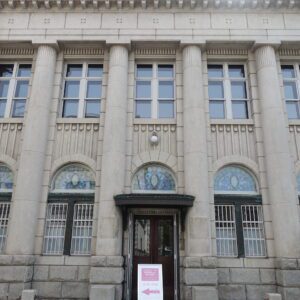
The Ohara Museum of Art Shin-Kojima-Kan (provisional name) was tentatively opened on October 1, 2021. It was open for free at the time of my visit. A huge sculpture by contemporary artist Kenji Yanobe, “Sun Sister (Rebirth)” is on display. “Sun Sister (Reverse)” stand up regularly.
1-300x300.jpg)
2-300x300.jpg)
“Kurashiki Bikan Historical Quarter” has been selected “National Preservation Districts for Groups of Traditional Buildings” as “Kurashiki City Kurashiki Riverside Traditional Buildings Preservation District”. It was a lot of fun to walk around the cityscape of “Kurashiki Bikan Historical Quarter”.
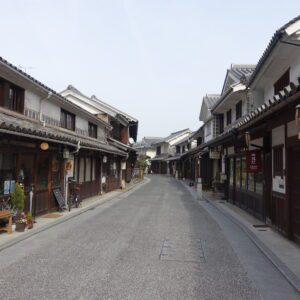
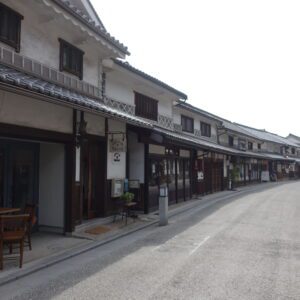
There is a “Kurashiki River Funa-nagashi” in the Kurashiki River in the “Kurashiki Bikan Historical Quarter”. Tickets are sold at the Kurashikikan Tourist Information Center for Yen 500 for adults and Yen 250 for children. The Yen 500 for adults was a great deal, and on the day I visited, the tickets were sold out around 15:00.
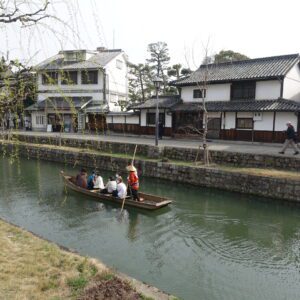
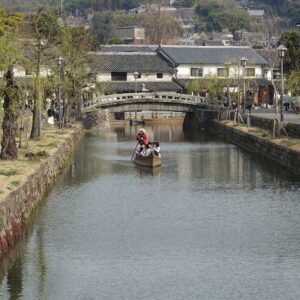
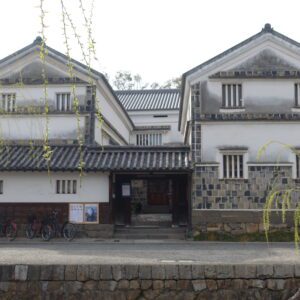
The Ohara Museum of Art is one of Japan’s leading museums. It is the first museum in Japan to display Western art and modern art. It opened in 1930.
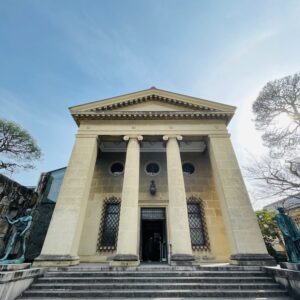
The Ohara Museum of Art Annex has been selected by DOCOMOMO (Documentation and Conservation of buildings, sites and neighborhoods of the Modern Movement) JAPAN as “Architecture of Modern Movements in Japan”.

Kurashiki Ivy Square is a multicultural facility that has been redeveloped from the head office factory of Kurabo Industries , which was built in 1889. There are accommodations, restaurants and Kurabo Memorial Hall on the premises.
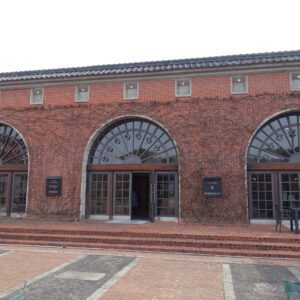
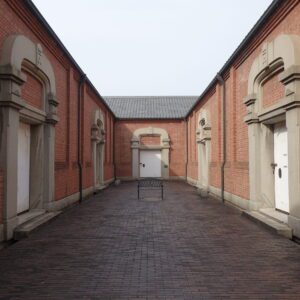

The former Ohara family residence was built in the late Edo period (late 1700s). There are typical features of Kurashiki such as the Kurashiki lattice on the first floor, the Kurashiki window on the second floor, and the Namako-Kabe ( a wall covered with square tiles jointed with raised plaster).
Previously, the owner of the Ohara family lived and the inside was not open to the public, but in April 2018, it was opened to the public as “Talking Theater Ohara Main House”.
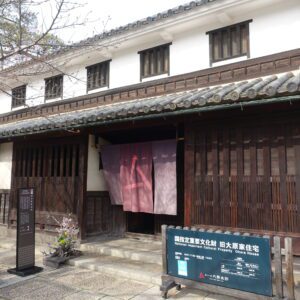

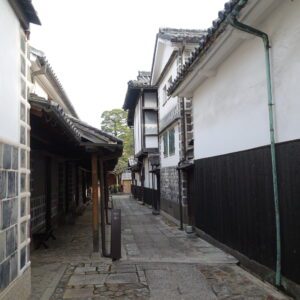
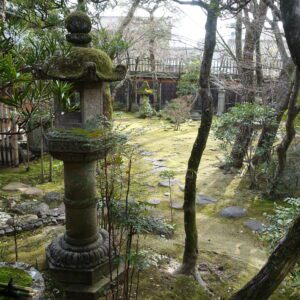
The former Ohara residence is a national important cultural property.
Yurinso is an old villa of the Ohara family built in 1928 by Magosaburo Ohara to live with his family. The building features a green tiled roof. Roof tiles baked by a unique manufacturing method glow green depending on the viewing angle. The contrast between the shade of green tiles and the earth-colored fence is also wonderful. It was also used as a lodging facility for Emperor Showa in 1947. The interior is open to the public at the time of a special exhibition sponsored by the Ohara Museum of Art, once a year in spring and autumn.
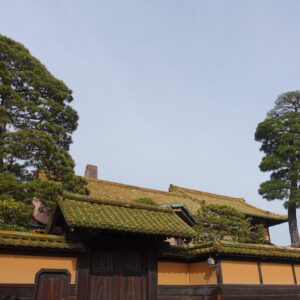
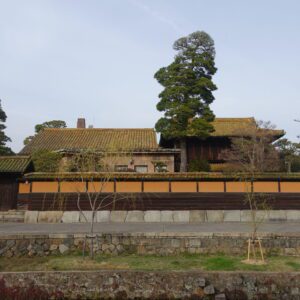
Meals
I returned to Fukuyama Station from Tomonoura, Myo-in and Kusado Inari Shrine, and had lunch at “Onomichi Ramen Iccho”.
I ordered “ramen” (Yen 650). The ramen of “Onomichi Ramen Iccho” was a typical “Onomichi ramen” with a lot of fatty upper part of roast pork floating in black soy sauce soup.

The taste of ramen was one of the best ramen I ate recently. The noodles were a little soft at “Kukai” in Onomichi City the day before, but the ramen at “Onomichi Ramen Iccho” was my favorite firm noodles. Also, because the soup contains a lot of fatty upper part of roast pork, it was a hot soup until I finished eating it.
After sightseeing in Kurashiki, I had dinner at “Local cuisine Hamayoshi“. I ordered “Assorted sashimi”, “Vinegared Mamakari (Japanese sardinella)”, “Berata (juvenile conger)”, “Ohitashi of yellow Chinese chives”, “Beka squid”, “Tako-miso (Liver of Octopus)” and “Tako-mochi (octopus egg) ”. I was able to eat various kinds of local dishes and delicacies.

The “Vinegared Mamakari (Japanese sardinella)” made by pickling the baked Mamakari of “Hamayoshi” was excellent. Usually, “Vinegared Mamakari” is pickled without baking Mamakari, but although the baked Mamakari is pickled, it has the aroma unique to grilled fish and has an exquisite taste.

“Berata (juvenile conger)” was also delicious with a smooth texture. “Berata” is a fry of conger eel and is the name in Okayama prefecture. It is called “Noresore” nationwide. In addition, “Noresore” is the name spread all over the country in Kochi prefecture. In Hyogo prefecture (Awaji Island and Akashi city), it is called “Hanatale”, and in Ibaraki prefecture, it is called “Peropero”. There are various names. “Berata” is often caught from January to March, so the end of March I ate was the last season.

“Ohitashi of yellow Chinese chives” is also selected as “Our Regional Cuisines” in Okayama prefecture. Yellow Chinese chives is a special product of Okayama prefecture and boasts 70% of the national production.

“Beka squid” is the “chii-chii squid” that I ate in Fukuyama City the day before. “Beka squid” I had the day before had a little smell (unique bitterness), but “Beka squid” of “Hamayoshi” had no smell at all. It was a very delicious “Beka squid”. The season for “Beka squid” in Okayama Prefecture is from April to mid-June.

The food that impressed me most at “Hamayoshi” was “Tako-miso (Liver of Octopus)”. I ate octopus liver for the first time in my life. Tako-miso is made by boiled down liver and seasoned with seasonings, frozen, and then sliced into thin slices at “Hamayoshi”. It was an excellent delicacy that goes well with sake. I can’t stop traveling because I can meet such exquisite dishes.
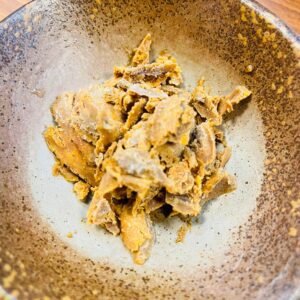
Important Points
I got off at Tomonoura bus stop, but if you want to start walking around the all‐night light stone lantern, it is more convenient to get off at Tomo Port bus stop, which is the end point. The Tomonoura Tourist Information Center is just off the Tomonoura bus stop. You should get off at Tomonoura bus stop to collect tourist information.
Note: The departure / arrival times, fares of transportation, admission fees, meal fees, etc. listed in the text are as of the time of writing the BLOG. Please check for yourself when you go on a trip as it may change in the future.